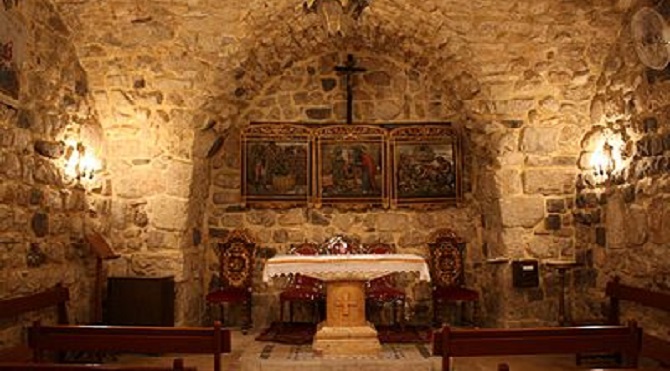Christianity in Syria: a policy of persecution or deliberate attempts to eliminate it once and for all (part 2)
By Milad Korkis Syriac journalist
There are also many significant Christian strongholds and holy places such as Saidnaya, Maaloula, Sadad, Deir Semaan (Church of St Simeon Stylites), the Dead City Serjilla and dozens of other Christian historical villages that were centers and sanctuaries for the saints of the early Christian era.
The residents of Syria were among the first people who converted to Christianity. The Syriacs (the ancient Syrians) embraced Christianity and Aramaic which was the language of Jesus Christ. Some Arab tribes that settled in Syria embraced Christianity; the Ghassanids in Houran, southern Syria, as well as the Banu Taghlib who settled in Aleppo and the Gozarto Region (al-Jazeera) in the pre-Islamic era. However, most of the Banu Taghlib converted to Islam in the 10th and 12th century C.E., while for the Ghassanids conversion happened more gradual and some Ghassanids remain Christian even today. Furthermore, several historical Syrian cities in early Christian times were home to churches, holy places, sanctuaries and pilgrimage centers.
The Syriac language has evolved in two dialects: Its Eastern or Assyrian dialect, and its Western or Aramaic dialect which became the daily language of Syria. Science and literature flourished, schools and universities emerged. The most famous were in Urhoy (Edessa), Nusaybin, Harran, and others. Syria is considered the first center and vocal point for a number of Christian denominations and Eastern Churches as well as a home to many apostles, saints, monks, and clergy. In the cities, towns and high mountains of the Syrian territory, there are dozens of monasteries, hundreds of churches and sanctuaries which highlight Christian history and give important insights in human civilization.
Christian emigration from Syria to the New World, especially towards the U.S. and Brazil started in the second half of the 19th century when migration opportunities opened up with the consular privileges for Christians. At that point, emigration was at modest pace but it accelerated and deepened in the mid-19th century especially in the Levant, in large part after the massacres of 1860.
Emigration drew people from both the countryside and the city. The high degree of injustice in the local feudal system, exorbitant taxes, forced recruitment and the Turkification policies adopted by the Committee of Union and Progress, as well as the European concessions were the main reasons of emigration. It nearly turned into a phenomenon.
Literary and civil associations which advocated the rights of expatriates had been established in the diaspora. These associations were linked to the popular memory through a group of songs. According to the historian Philip Hitti, about 900,000 people from Ottoman Syria emigrated to the U.S. between 1899 -1919. More than 90% of the immigrants were Syrian Christians. The Eastern Christian communities had become prominent and well-integrated in South America. They emerged in business, commerce, banking, industry, and politics.
Christians made up about 30 % of the Syrian population at the beginning of the 20th century. Their number was relative higher in Damascus, Homs, Latakia and the Gozarto Region (al-Jazeera), exceeding one third of the population. They were less present in Aleppo, Hama, and Idlib.
The French general Henry Gouraud who from 1919 to 1923 served as the High Commissioner of the French Mandates in Syria and Lebanon wanted to come to agreements with the Syrians after their confrontation with French forces in the Battle of Maysalun (23 July 1920). Between 1920-1921 General Henry Gouraud issued several decrees aimed at dividing Syria on a sectarian basis. The decrees would result in the creation of six independent states;
- Damascus, in which Christians constituted about 11.3 % of the population;
- Aleppo which was home to one of the richest and most diverse Eastern Christian communities in the East. Christians constituted about 8.6 % of the population;
- Jabal Alawite, in which Christians constituted about 11.7 % of the population;
- Jabal Druze, in which Christians constituted about 13.8 % of the population;
- Gozarto Region (al-Jazeera), in which Christians constituted about 29.1 % of the population;
- Iskenderun District, in which Christians constituted about 19 % of the population.
Many of the Syria’s Christians played an important and leading cultural and intellectual role. They were active in the politic struggle during the French Mandate period in Syria. During that period, three most prominent Syrian thinkers who reflected the political diversity of the Christians were Michel Aflaq and Elias Morcos, who both advocated socialism and Arab nationalism, and Antoun Saadeh, Syrian nationalist and founder of the Syrian Social Nationalist Party. Also Fares al-Khoury who represented moderate Syrian Capitalism and the balance between the National bond and the Patriotic link. Al-Khoury managed to form several governments during the presidencies of Hashim al-Atassi and Shukri al-Quwatli.
To be continued…























